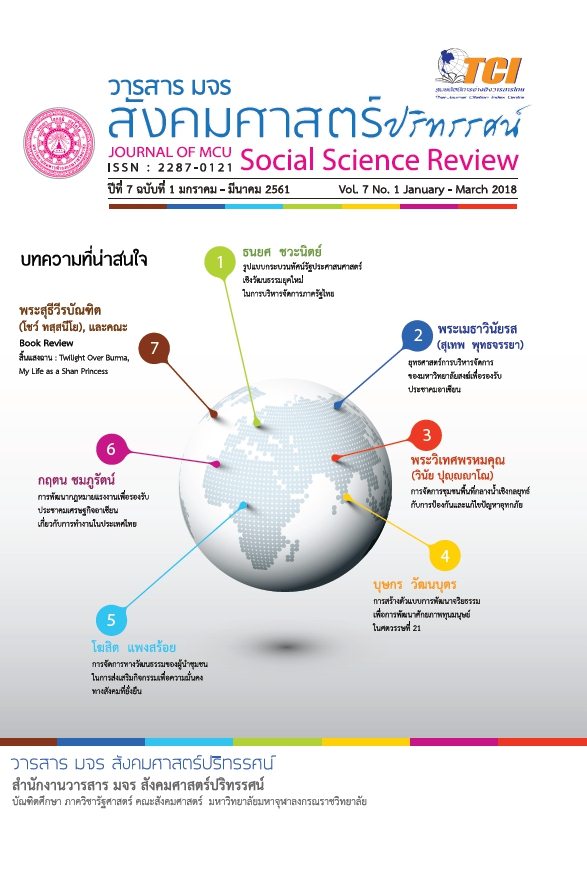กลยุทธ์การบริหารองค์กรสงฆ์ที่เข้มแข็งในยุคโลกาภิวัตน์
คำสำคัญ:
Sangha administration, strategies , globalizationบทคัดย่อ
บทความนี้มีวัตถุประสงค์เพื่อ 1) ศึกษาวิเคราะห์สภาพทั่วไปในการบริหารองค์กรสงฆ์ในปัจจุบัน 2) ศึกษากลยุทธ์การบริหารองค์กรสงฆ์ที่เข้มแข็งในยุคโลกาภิวัตน์ 3) นำเสนอกลยุทธ์การบริหารองค์กรสงฆ์ที่เข้มแข็งในยุคโลกาภิวัตน์
การวิจัยครั้งนี้เป็นการวิจัยแบบผสานวิธี (Mixed Method Research) ระหว่างงานวิจัยเชิงคุณภาพ (Qualitative Research) ด้วยการสัมภาษณ์เชิงลึก (In depth Interview) กับผู้ให้ข้อมูลสำคัญซึ่งเป็นพระสังฆาธิการผู้มีบทบาทสำคัญในการบริหารกิจการคณะสงฆ์และผู้ทรงคุณวุฒิ จำนวน 18 รูปหรือคน และการสนทนากลุ่มเฉพาะ (Focus Group Discussion) กับผู้เชี่ยวชาญจำนวน 8 ท่าน และงานวิจัยเชิงปริมาณ (Quantitative Research) ด้วยการวิจัยเชิงสำรวจ (Survey Research) กับประชากรกลุ่มตัวอย่าง จำนวน 363 คน
ผลการวิจัยพบว่า
- สภาพทั่วไปในการบริหารองค์กรสงฆ์ในปัจจุบัน พบว่า คณะสงฆ์มีทรัพยากรบุคคลจำนวนมากที่ความรู้ ความสามารถ และมีทักษะในการปฏิบัติงาน แต่กลับพบจุดอ่อนคือ พระสงฆ์กลุ่มดังกล่าวยังขาดการสนับสนุนที่ดีจากเจ้าคณะผู้ปกครอง ส่งผลให้พระสงฆ์ที่มีความรู้ความสามารถไปรวมตัวกันอยู่เฉพาะวัดหรือสำนักเรียนใหญ่ๆ ที่มีความพร้อมมากกว่า ส่งผลให้วัดขนาดเล็กขาดบุคลากรในการพัฒนาอย่างต่อเนื่อง ในขณะที่โอกาสของคณะสงฆ์ก็คือ การมีพระราชบัญญัติคณะสงฆ์เป็นของตนเองและการมีหน่วยงานของรัฐ ที่ตั้งขึ้นเพื่อรับผิดชอบงานคณะสงฆ์เป็นการเฉพาะ การมีเทคโนโลยีที่ทันสมัยจะช่วยสนับสนุนให้การบริหารงานคณะสงฆ์มีประสิทธิภาพมากยิ่งขึ้น ส่วนอุปสรรคกลับพบว่า คณะสงฆ์มีการเผชิญหน้ากับความหลากหลายทางด้ายวัฒนธรรม ความเจริญก้าวหน้าทางด้านเศรษฐกิจทำให้ประชาชนไม่มีเวลาเข้าวัด การแทรกแซงจากนโยบายรัฐบาล และการเสพสื่อผิดๆ ของพุทธศาสนิกชน เมื่อสอบถามความคิดเห็นของประชาชนต่อสภาพทั่วไปในการบริหารองค์กรสงฆ์ในปัจจุบันโดยภาพรวมใน 5 ด้าน ได้แก่
1. ด้านศาสนบุคคล 2. ด้านศาสนธรรม 3. ด้านศาสนพิธี 4. ด้านศาสนสถาน และ 5. ด้านระบบเทคโนโลยี พบว่า ประชาชนมีความคิดเห็นต่อสภาพทั่วไปในการบริหารองค์กรสงฆ์ในปัจจุบันโดยภาพรวมอยู่ในระดับมาก ( =3.92, S.D.= 0.639) เมื่อพิจารณาเป็นรายด้าน พบว่า อยู่ในระดับมากทุกด้าน - ผลการวิเคราะห์กลยุทธ์การบริหารองค์กรสงฆ์ที่เข้มแข็งในยุคโลกาภิวัตน์ พบว่า เมื่อนำจุดแข็งและโอกาสมาวิเคราะห์ร่วมกัน ทำให้ได้กลยุทธ์เชิงรุกและสามารถปฏิบัติได้ทันที มี 2 กลยุทธ์ คือ กลยุทธ์การสร้างศาสนทายาทที่เข้มแข็ง และกลยุทธ์การพัฒนาระบบเทคโนโลยีที่ทันสมัย เมื่อนำจุดแข็งและอุปสรรคมาวิเคราะห์ร่วมกัน ทำให้ได้กลยุทธ์เชิงรักษาระดับ เชิงทำลายและเชิงลดอุปสรรค มี 2 กลยุทธ์ คือ กลยุทธ์การสร้างภาพลักษณ์ที่ดีให้องค์กร และกลยุทธ์การเน้นการมีส่วนร่วมของประชาชน เมื่อนำจุดอ่อนและโอกาสมาวิเคราะห์ร่วมกัน ทำให้ได้กลยุทธ์เชิงปรับปรุงแก้ไข เชิงฟื้นฟู มี 2 กลยุทธ์ คือ กลยุทธ์การนำหลักธรรมสู่การปฏิบัติให้มากขึ้น และกลยุทธ์การฟื้นฟูประเพณีอันดีงามให้คงไว้ และเมื่อนำจุดอ่อนและอุปสรรคมาวิเคราะห์ร่วมกัน ทำให้ได้กลยุทธ์เชิงถอย ชะลอ ลด และหนี มี 2 กลยุทธ์ คือ กลยุทธ์การเสริมสร้างความรัก ความสามัคคีแก่พุทธบริษัท และกลยุทธ์การจัดหาแหล่งงบประมาณสนับสนุน
- นำเสนอกลยุทธ์การบริหารองค์กรสงฆ์ที่เข้มแข็งในยุคโลกาภิวัตน์ มี 8 กลยุทธ์ คือ 1) กลยุทธ์การจัดหาแหล่งงบประมาณสนับสนุน 2) กลยุทธ์การเสริมสร้างความรัก ความสามัคคีแก่พุทธบริษัท 3) กลยุทธ์การฟื้นฟูประเพณีอันดีงามให้คงไว้ 4) กลยุทธ์การนำหลักธรรมสู่การปฏิบัติให้มากขึ้น 5) กลยุทธ์การสร้างศาสนทายาทที่เข้มแข็ง 6) กลยุทธ์การสร้างภาพลักษณ์ที่ดีให้องค์กร 7) กลยุทธ์การพัฒนาระบบเทคโนโลยีที่ทันสมัย 8) กลยุทธ์การเน้นการมีส่วนร่วมของประชาชน ทั้งนี้ทั้ง 8 กลยุทธ์ดังกล่าวหากคณะสงฆ์ดำเนินการอย่างต่อเนื่องก็จะทำให้ยุทธศาสตร์การสร้างความมั่นคงด้านพระพุทธศาสนาประสบผลสำเร็จ ภายใต้ค่านิยมขององค์กร คืออุทิศตนเพื่อพระพุทธศาสนา สู่การพัฒนาสังคมอย่างยั่งยืน ทุกยุทธศาสตร์สร้างขึ้นเพื่อให้พันธกิจขององค์กรประสบผลสำเร็จ พันธกิจของคณะสงฆ์มี 7 ด้าน ได้แก่ ด้านปกครอง ด้านศาสนศึกษา ด้านศึกษาสงเคราะห์ ด้านเผยแผ่ ด้านสาธารณูปการ ด้านสาธารณสงเคราะห์ พัฒนพุทธมณฑล ทั้งนี้ดำเนินการภายใต้วิสัยทัศน์เดียวกัน คือพุทธศาสตร์มั่นคง ดำรงศีลธรรม นำสังคมสันติสุขอย่างยั่งยืน
เอกสารอ้างอิง
Nakarin Kheawchotrung. (2013). "The Form and Principle of Rule in the Tipitaka". Dissertation. Faculty of Buddhism. Graduate School: Mahachulalongkorn-
rajavidyalaya University.
Nantawan Isaranuwatchai. (2007). Leadership in Globalization: A Study of Buddhist Dhamma (Master Thesis). Graduate School: Mahachulalongkorn-
rajavidyalaya University.
Phra Thep Rattana Suthi Somsak Chotintaroo. (2014). Strategy of the Buddhist Sangha Region 1 (Dissertation). Graduate School of Buddhist Studies. Graduate School: Mahachulalongkornrajavidyalaya University
PhrakhrupipitPatanasophon Udom Sunthethe. (2014).The Development of Buddhist Rulers According to Morality. in The Buddhist Sangha Region 2 (Dissertation) Graduate School of Buddhist Studies. Graduate School: Mahachulalongkornrajavidyalaya University.
Sin Panphinit. (2004). Research Techniques in Social Science. Bangkok: Tuning Publishing Company.
Sudaporn Aroondee. (2008). Basic Knowledge of Research. Loei: Rung Sang Printing.
Suwaree Siripochapirom.(2003). Educational Research. Lopburi: Printing Department. Rajabhat Institute.
Surapon Suyaprom. (2012). Thai Sangha Control and Hierarchy. Journal of MCU Social Science Review, 1(1), 37-51
ดาวน์โหลด
เผยแพร่แล้ว
รูปแบบการอ้างอิง
ฉบับ
ประเภทบทความ
สัญญาอนุญาต
ลิขสิทธิ์ (c) 2019 วารสาร มจร สังคมศาสตร์ปริทรรศน์

อนุญาตภายใต้เงื่อนไข Creative Commons Attribution-NonCommercial-NoDerivatives 4.0 International License.
เพื่อให้เป็นไปตามกฎหมายลิขสิทธิ์ ผู้นิพนธ์ทุกท่านต้องลงลายมือชื่อในแบบฟอร์มใบมอบลิขสิทธิ์บทความให้แก่วารสารฯ พร้อมกับบทความต้นฉบับที่ได้แก้ไขครั้งสุดท้าย นอกจากนี้ ผู้นิพนธ์ทุกท่านต้องยืนยันว่าบทความต้นฉบับที่ส่งมาตีพิมพ์นั้น ได้ส่งมาตีพิมพ์เฉพาะในวารสาร มจร สังคมศาสตร์ปริทรรศน์ เพียงแห่งเดียวเท่านั้น หากมีการใช้ภาพหรือตารางหรือเนื้อหาอื่นๆ ของผู้นิพนธ์อื่นที่ปรากฏในสิ่งตีพิมพ์อื่นมาแล้ว ผู้นิพนธ์ต้องขออนุญาตเจ้าของลิขสิทธิ์ก่อน พร้อมทั้งแสดงหนังสือที่ได้รับการยินยอมต่อบรรณาธิการ ก่อนที่บทความจะได้รับการตีพิมพ์ หากไม่เป็นไปตามข้อกำหนดเบื้องต้น ทางวารสารจะถอดบทความของท่านออกโดยไม่มีข้อยกเว้นใดๆ ทั้งสิ้น





